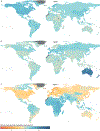The global landscape of smallpox vaccination history and implications for current and future orthopoxvirus susceptibility: a modelling study
- PMID: 36455590
- PMCID: PMC10040439
- DOI: 10.1016/S1473-3099(22)00664-8
The global landscape of smallpox vaccination history and implications for current and future orthopoxvirus susceptibility: a modelling study
Abstract
Background: More than four decades after the eradication of smallpox, the ongoing 2022 monkeypox outbreak and increasing transmission events of other orthopoxviruses necessitate a greater understanding of the global distribution of susceptibility to orthopoxviruses. We aimed to characterise the current global landscape of smallpox vaccination history and orthopoxvirus susceptibility.
Methods: We characterised the global landscape of smallpox vaccination at a subnational scale by integrating data on current demography with historical smallpox vaccination programme features (coverage and cessation dates) from eradication documents and published literature. We analysed this landscape to identify the factors that were most associated with geographical heterogeneity in current vaccination coverage. We considered how smallpox vaccination history might translate into age-specific susceptibility profiles for orthopoxviruses under different vaccination effectiveness scenarios.
Findings: We found substantial global spatial heterogeneity in the landscape of smallpox vaccination, with vaccination coverage estimated to range from 7% to 60% within admin-1 regions (ie, regions one administrative level below country) globally, with negligible uncertainty (99·6% of regions have an SD less than 5%). We identified that geographical variation in vaccination coverage was driven mostly by differences in subnational demography. Additionally, we found that susceptibility for orthopoxviruses was highly age specific based on age at cessation and age-specific coverage; however, the age profile was consistent across vaccine effectiveness values.
Interpretation: The legacy of smallpox eradication can be observed in the current landscape of smallpox vaccine protection. The strength and longevity of smallpox vaccination campaigns globally, combined with current demographic heterogeneity, have shaped the epidemiological landscape today, revealing substantial geographical variation in orthopoxvirus susceptibility. This study alerts public health decision makers to non-endemic regions that might be at greatest risk in the case of widespread and sustained transmission in the 2022 monkeypox outbreak and highlights the importance of demography and fine-scale spatial dynamics in predicting future public health risks from orthopoxviruses.
Funding: US National Institutes of Health and US National Science Foundation.
Copyright © 2023 Elsevier Ltd. All rights reserved.
Conflict of interest statement
Declaration of interests We declare no competing interests.
Figures



Comment in
-
Role of immunity landscape in global risk assessment of re-emerging diseases.Lancet Infect Dis. 2023 Apr;23(4):385-386. doi: 10.1016/S1473-3099(22)00756-3. Epub 2022 Nov 28. Lancet Infect Dis. 2023. PMID: 36455592 Free PMC article. No abstract available.
References
-
- Fenner F, Henderson DA, Arita I, Jezek Z, Ladnyi ID, World Health Organization, et al. Smallpox and its eradication. World Health Organization; 1988.
-
- Cherry J, McIntosh K, Connor J, Benenson A, Alling D, Rolfe U, et al. Clinical and serologic study of four smallpox vaccines comparing variations of dose and route of administration. Primary percutaneous vaccination. The Journal of Infectious Diseases. 1977;135(1):145–54. - PubMed
-
- World Health Organization. The global eradication of smallpox: Final report of the Global Commission for the Certification of Smallpox Eradication, Geneva, December 1979. World Health Organization; 1980.

